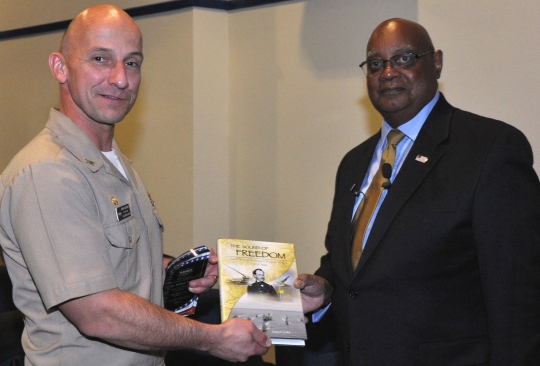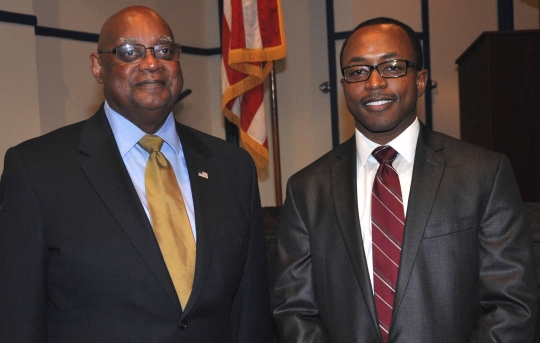 DAHLGREN, Va. - Capt. Brian Durant, Naval Surface Warfare Center Dahlgren Division (NSWCDD) commander, presents the Dahlgren history book, "The Sound of Freedom," to Dr. William Bundy, Gravely Naval Warfare Research Group director, at the 2016 Black History Month Observance, Feb. 11. "The research and development progress that was shared with me on the railgun and directed energy systems was very reassuring," said Bundy, a U.S. Naval War College professor who toured NSWCDD electromagnetic railgun and directed energy facilities after inspiring a military and civilian audience with his keynote speech at the observance. "Those capabilities will certainly deliver advantages for our maritime forces. It was absolutely encouraging to witness first-hand the remarkable effort and work that is continuing today at Dahlgren." (U.S. Navy photo by Barbara Wagner/Released)
DAHLGREN, Va. - Capt. Brian Durant, Naval Surface Warfare Center Dahlgren Division (NSWCDD) commander, presents the Dahlgren history book, "The Sound of Freedom," to Dr. William Bundy, Gravely Naval Warfare Research Group director, at the 2016 Black History Month Observance, Feb. 11. "The research and development progress that was shared with me on the railgun and directed energy systems was very reassuring," said Bundy, a U.S. Naval War College professor who toured NSWCDD electromagnetic railgun and directed energy facilities after inspiring a military and civilian audience with his keynote speech at the observance. "Those capabilities will certainly deliver advantages for our maritime forces. It was absolutely encouraging to witness first-hand the remarkable effort and work that is continuing today at Dahlgren." (U.S. Navy photo by Barbara Wagner/Released)DAHLGREN, Va. (Feb. 20, 2016)—Dr. William Bundy recalled the day he missed the bus for the March on Washington for Jobs and Freedom in Washington, D.C.
It was Aug. 28, 1963 and he would have had the chance to hear Dr. Martin Luther King speak.
"I had to go home and get permission from my Mom and when I got back to Bethel AME Church the bus was gone," the 2016 Naval Surface Warfare Center Dahlgren Division (NSWCDD) Black History Celebration keynote speaker told the audience at the base theater, Feb. 11.
Eventually he met the civil rights leader.
"Inspirational" is how Bundy described his 10-minute conversation with King at Penn Station in New York City.
"I just arrived from England. My ship was deployed and I was leaving the ship. I was in uniform and he was standing there all by himself," said Bundy. "I walked over and talked to him. The civil rights struggle that he represented is very important to all of us, but from the Navy perspective I want you to understand that we've been there. We're still there and as a race, our heritage is strong."
Throughout the month of February, the Navy joins our nation in celebrating the history and culture of African-American and Black Sailors during African-American/Black History Month.
Established in 1926, President Gerald Ford expanded the celebration in 1976 to include the entire month of February. This year, Navy commands are encouraged to celebrate and reflect on the theme "Hallowed Grounds: Sites of African-American Memories."
Bundy—a retired Navy Captain who began his Navy career as a sonar technician—reflected on the lives and service of African-Americans, especially those who died in combat, making the land and seas from Pearl Harbor to the skies over Korea hallowed.
He spoke about Doris "Dorie" Miller who enlisted as a Navy Mess Attendant 3rd Class in September 1939. Miller distinguished himself by courageous conduct and devotion to duty during the Japanese attack on Pearl Harbor on Dec. 7, 1941, while serving aboard USS West Virginia (BB-48). He was awarded the Navy Cross for his actions on this occasion. Miller then served aboard USS Indianapolis (CA-35) from December 1941 to May 1943. He was next assigned to the escort carrier Liscome Bay (CVE-56). He was lost with that ship when it was torpedoed by a Japanese submarine on Nov. 24, 1943, during the invasion of the Gilbert Islands. On Nov. 25, 1944, Miller was presumed dead by the Secretary of the Navy a year and a day after being carried as missing in action since the Nov. 24, 1943 attack on the Liscome Bay. USS Miller (DE-1091) was named in honor of Cook Third Class Doris Miller.
Bundy also recounted Ens. Jesse LeRoy Brown, the Navy's first black aviator, who wanted not only to fly, but to be of service to mankind. On Dec. 4, 1950, Brown's aircraft was hit while making a strafing run against the enemy during the Korean War. With tremendous skill, he managed to crash land on a rough, boulder-strewn slope. He survived the crash, only to remain stuck in the cockpit as smoke began to billow from the wreckage. He risked his life to help a Marine regiment without any race considerations, knowing only that Americans were in trouble. Although his career was met from start to tragic finish with immeasurable odds, his courage and devotion live on throughout our Navy's history.
"Jessie L. Brown consecrated that land, making it hallow," said Bundy, emphasizing that the naval aviator left behind a legacy. "Based on his story, Marine Corps general Frank Petersen—who was a seaman apprentice in the Navy—decided to really pick himself up by the bootstraps and become a pilot."
Petersen, the first African-American Marine Corps aviator and the first African-American Marine Corps general, served during the Korean War in 1953 and Vietnam in 1968. During his career, he flew more than 350 combat missions and more than 4,000 hours in various military aircraft.
Winston Scott—former NASA astronaut and retired U.S. Navy Captain—among others also followed Brown's example.
"It all started with Jesse L. Brown," said Bundy, director of the Gravely Naval Warfare Research Group and a U.S. Naval War College professor. "It has to start somewhere, and these are the foundations on which I hope to leave an impression on you. That junior engineer or junior administrator under your supervision needs more than just supervision. They need sponsorship—somebody that is going to get me that next difficult job. Somebody that is going to make sure that when I complete that job, it's communicated to senior leadership so that when promotions and opportunities arise, people are prepared. As you see these heroic Sailors, we'll start with that discussion. They are not black Sailors, they are courageous Navy fighting men."
Scott's journey to the stars started in Miami. His largely segregated education provided little access to resources, but his own determination combined with the dedication of his teachers, set him on an inspiring path of achievement. Scott entered Naval Aviation Officer Candidate School in 1973 and was designated a naval aviator in 1974. As a naval aviator, Scott piloted the F-14 Tomcat, F/A-18 Hornet, and the A-7 Corsair. All together he has flown more than 5,000 flight hours on 20 different aircraft. He was selected by NASA for the astronaut program and reported to the Johnson Space Center in August 1992. He served as a mission specialist on STS-72 in 1996, and STS-87 in 1997, and has logged a total of 24 days, 14 hours and 34 minutes in space, including three spacewalks totaling 19 hours and 26 minutes.
"I really believe that diversity and inclusion is about leadership from the top," said Bundy, one of the Centennial Seven African-American submarine skippers who served during the first one-hundred years of the Navy's submarine service. "It is about accountability throughout the chain of command. It's about human development. We need everybody. We are in the fight for our lives. There are countries out there that are able to produce faster than us. They know what we do. They are trying to push us out and we need every one of you, and others who are still playing Xbox at home to come join us in this fight.
"China produces 100,000 engineers a year and we're nowhere close. So when you have those STEM (science, technology, engineering and mathematics) programs—be inclusive. When you have the opportunity to bring someone along—bring them along. We are one Navy, and I believe this observance is about recognizing who we are, what we're up against, and for us to come together individually, and as an organization, so we can continue to enjoy the liberty, freedom, and access we have today."
After the observance, Bundy toured the NSWCDD electromagnetic railgun and directed energy facilities.
"My tour reinforced my belief that Dahlgren remains a center for innovation and development of credible combat capabilities," said Bundy. "The research and development progress that was shared with me on the railgun and directed energy systems was very reassuring. Those capabilities will certainly deliver advantages for our maritime forces. It was absolutely encouraging to witness first-hand the remarkable effort and work that is continuing today at Dahlgren."
 DAHLGREN, Va. - Dr. William Bundy, Gravely Naval Warfare Research Group director, and Michael Hobson, Naval Surface Warfare Center Dahlgren Division (NSWCDD) Black Employment Program manager (right), meet after Bundy's keynote speech at the NSWCDD 2016 Black History Month Observance, Feb. 11. In his speech, Bundy - a retired Navy Captain who began his Navy career as a sonar technician - reflected on the lives and service of African-Americans, especially those who died in combat, making the land and seas from Pearl Harbor to the skies over Korea hallow. (U.S. Navy photo by Barbara Wagner/Released)
DAHLGREN, Va. - Dr. William Bundy, Gravely Naval Warfare Research Group director, and Michael Hobson, Naval Surface Warfare Center Dahlgren Division (NSWCDD) Black Employment Program manager (right), meet after Bundy's keynote speech at the NSWCDD 2016 Black History Month Observance, Feb. 11. In his speech, Bundy - a retired Navy Captain who began his Navy career as a sonar technician - reflected on the lives and service of African-Americans, especially those who died in combat, making the land and seas from Pearl Harbor to the skies over Korea hallow. (U.S. Navy photo by Barbara Wagner/Released)

